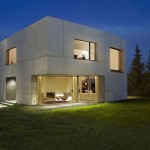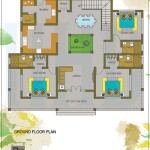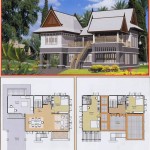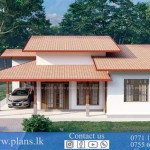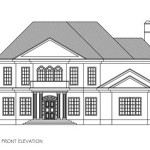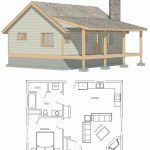House Plans: Exploring the Versatility of 1, 2 Story, and Ranch Designs
Selecting the ideal house plan can be a daunting task, given the vast array of architectural styles, sizes, and features available. Among the most popular options are one-story, two-story, and ranch-style homes, each presenting unique advantages and considerations. Understanding the nuances of these designs is crucial in making an informed decision that aligns with individual needs, lifestyle, and long-term goals.
House plans serve as a blueprint for the construction process, outlining the layout, dimensions, and structural elements of the dwelling. These plans are essential for obtaining building permits, estimating construction costs, and ensuring that the finished product meets the desired specifications. Architects and designers meticulously craft these plans, taking into account factors such as local building codes, zoning regulations, and the homeowner's specific requirements.
The choice between a one-story, two-story, or ranch-style house often hinges on factors such as lot size, budget considerations, accessibility needs, and aesthetic preferences. Each style offers a distinct living experience, impacting everything from energy efficiency to maintenance requirements. A thorough evaluation of these factors is paramount in selecting the house plan that best suits individual circumstances.
One-Story House Plans: Simplicity and Accessibility
One-story house plans, also known as ramblers or single-story homes, are characterized by their horizontal layout, with all living spaces situated on a single level. This design offers several advantages, particularly in terms of accessibility and convenience. Because there are no stairs, one-story homes are ideal for individuals with mobility limitations, families with young children, and those who prefer the ease of navigating a single level.
The absence of stairs also contributes to enhanced safety, reducing the risk of falls, particularly for elderly residents. Furthermore, one-story homes often feature open floor plans, which promote natural light and create a spacious, airy atmosphere. This design can also facilitate communication and interaction among family members, as there are fewer physical barriers between living spaces.
From a construction standpoint, one-story homes can be generally less expensive to build than two-story homes, as they require less structural support and complex engineering. The simplicity of the design also translates to lower maintenance costs, as there are fewer exterior surfaces to maintain and repair. However, one-story homes typically require a larger lot size compared to two-story homes, as all living spaces are spread out horizontally.
Energy efficiency can be a mixed bag with one-story homes. While heating and cooling costs may be lower due to the lack of vertical space, heat loss through the roof can be a concern. Proper insulation and ventilation are crucial in mitigating these effects and ensuring optimal energy performance. Window placement and orientation also play a significant role in maximizing natural light and minimizing solar heat gain.
Resale value is another factor to consider when choosing a one-story home. While they are generally appealing to a wide range of buyers, their desirability may vary depending on the location and local market conditions. In areas where land is scarce, a two-story home may be more highly valued due to its ability to maximize living space on a smaller lot.
Two-Story House Plans: Maximizing Space and Efficiency
Two-story house plans, as the name suggests, feature living spaces spread across two levels. This design is particularly well-suited for smaller lots, as it maximizes living space without requiring a sprawling footprint. Two-story homes often offer a greater degree of privacy, as bedrooms are typically located on the upper level, separated from the main living areas on the ground floor.
From an energy efficiency standpoint, two-story homes generally perform better than one-story homes, as they have a smaller roof area relative to the total living space. This reduces heat loss during the winter and heat gain during the summer. The vertical design also allows for natural convection, which can further enhance energy efficiency. However, proper insulation and ventilation are still crucial in maintaining a comfortable indoor environment.
The construction costs of two-story homes can be higher than those of one-story homes, as they require more structural support and complex engineering. Stairs also add to the overall cost of construction. However, the ability to maximize living space on a smaller lot can offset these costs, particularly in areas where land is expensive.
Two-story homes offer a wide range of architectural styles, from traditional to contemporary. This versatility allows homeowners to customize their homes to reflect their personal preferences and complement the surrounding environment. The upper level often provides opportunities for expansive views, which can further enhance the living experience.
Accessibility can be a concern in two-story homes, particularly for individuals with mobility limitations. However, elevators or stair lifts can be installed to address this issue. The cost of these modifications should be factored into the overall budget if accessibility is a primary consideration.
Ranch-Style House Plans: Blending Indoor and Outdoor Living
Ranch-style house plans, a subset of one-story homes, emerged in the mid-20th century and are characterized by their low-pitched roofs, horizontal layouts, and attached garages. They often feature large windows and sliding glass doors, blurring the lines between indoor and outdoor living. Ranch homes are typically built on a slab foundation, which eliminates the need for stairs and further enhances accessibility.
The open floor plans of ranch homes promote natural light and create a spacious, airy atmosphere. They are well-suited for entertaining and can easily accommodate large gatherings. The horizontal layout also facilitates flow between different living spaces, making it easy to navigate the home.
Maintenance can be relatively straightforward with ranch homes, as there are fewer exterior surfaces to maintain. The low-pitched roofs are also easier to access for cleaning and repairs. However, the expansive footprint of ranch homes can result in higher heating and cooling costs, particularly in climates with extreme temperatures. Proper insulation and ventilation are essential in mitigating these effects.
Ranch homes offer a wide range of design options, from traditional to modern. They can be customized to reflect individual preferences and needs. The attached garage provides convenient access to the home and can also serve as a workshop or storage space.
While historically associated with larger lots, contemporary interpretations of the ranch style are increasingly adapted for smaller properties. "Modern Ranch" designs often incorporate vertical elements and clever space-saving solutions, without sacrificing the core principles of open-plan living and seamless indoor-outdoor connection.
Landscaping plays a crucial role in enhancing the curb appeal of ranch homes. A well-maintained yard can complement the horizontal lines of the house and create a welcoming environment. Patios, decks, and other outdoor living spaces can further extend the living area and provide opportunities for relaxation and recreation.
The choice between a one-story, two-story, or ranch-style home ultimately depends on individual needs and preferences. Each style offers unique advantages and considerations. By carefully evaluating these factors, homeowners can select the house plan that best suits their lifestyle and long-term goals. The design considerations around heating and cooling energy efficiency should be a key consideration in making the choice.

10 Gorgeous Ranch House Plans Ideas Two Story And More One

Rectangular House Plans Google Search Rectangle Ranch Style One Story

Silverbell Ranch House Plan Farmhouse Archival Designs

House Plan 45467 Ranch Style With 1680 Sq Ft 4 Bed 2 Bath

House Plan 034 00654 Ranch 1 883 Square Feet 3 Bedrooms 2 Bathrooms Craftsman Plans

House Plan 66419ll Ranch Ahmann Design

The Pineview Floor Plan 2 Bed Bath Single Story Ranch House 1500sq Ft

Ranch House Plans Style Home Designs The Designers

Peach Tree House Plan Ranch Floor Designs

Ranch House Plans Bungalow With Garage


